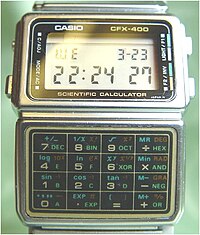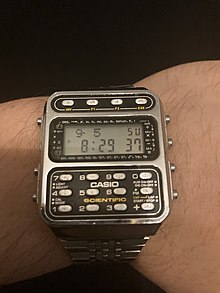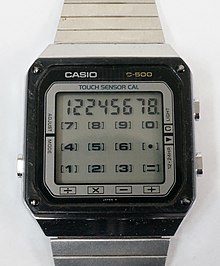
An electronic calculator is typically a portable electronic device used to perform calculations, ranging from basic arithmetic to complex mathematics.

A watch is a portable timepiece intended to be carried or worn by a person. It is designed to keep a consistent movement despite the motions caused by the person's activities. A wristwatch is designed to be worn around the wrist, attached by a watch strap or other type of bracelet, including metal bands, leather straps, or any other kind of bracelet. A pocket watch is designed for a person to carry in a pocket, often attached to a chain.

Casio Computer Co., Ltd. is a Japanese multinational electronics manufacturing corporation headquartered in Shibuya, Tokyo, Japan. Its products include calculators, mobile phones, digital cameras, electronic musical instruments, and analogue and digital watches. It was founded in 1946, and in 1957 introduced the first entirely compact electronic calculator. It was an early digital camera innovator, and during the 1980s and 1990s, the company developed numerous affordable home electronic keyboards for musicians along with introducing the first mass-produced digital watches.

A scientific calculator is an electronic calculator, either desktop or handheld, designed to perform calculations using basic and complex mathematical operations and functions. They have completely replaced slide rules and are used in both educational and professional settings.
Timex Group USA, Inc. is an American global watch manufacturing company founded in 1854 as the Waterbury Clock Company in Waterbury, Connecticut. In 1944, the company became insolvent but was reformed into Timex Corporation. In 2008, the company was acquired by Timex Group B.V. and was renamed Timex Group USA.

The TI-30 is a scientific calculator manufactured by Texas Instruments, the first model of which was introduced in 1976. While the original TI-30 was discontinued in 1983 after several design revisions, TI maintains the TI-30 designation as a branding for its low and mid-range scientific calculators.
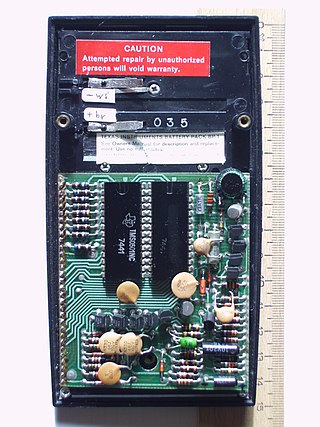
The SR-50 was Texas Instruments' first scientific pocket calculator with trigonometric and logarithm functions. It enhanced their earlier SR-10 and SR-11 calculators, introduced in 1973, which had featured scientific notation, squares, square root, and reciprocals, but had no trig or log functions, and lacked other features. The SR-50 was introduced in 1974 and sold for US$170. It competed with the Hewlett-Packard HP-35.
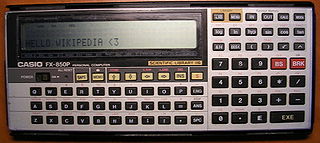
The Casio FX-850P is a scientific calculator introduced in 1987 and sold until 1999.

The G-Shock is a line of watches manufactured by the Japanese electronics company Casio, designed to resist mechanical stress, shock and vibration. G-Shock is an abbreviation for Gravitational Shock. The watches in the G-Shock line are designed primarily for sports, military and outdoors-oriented activities; all G-Shocks have a chronograph feature, 200 metre water resistance and an alarm, with either a digital display, analogue display or a combination of analogue and digital displays. Other features such as a countdown timer, world clock, and a backlight are included in most models. Newer high-end models in the line also feature GPS, directional, pressure and temperature sensors, radio-controlled time adjustment and Bluetooth time adjustment achieved by connecting the watch to a smartphone via a dedicated application.

The Casio FX-7000G is a calculator which is widely known as being the world's first graphing calculator available to the public. It was introduced to the public and later manufactured between 1985 and c. 1988. Notable features are its ability to graph functions, and that it is programmable. The calculator offers 82 scientific functions and is capable of manual computation for basic arithmetic problems.
Programmable calculators are calculators that can automatically carry out a sequence of operations under control of a stored program. Most are Turing complete, and, as such, are theoretically general-purpose computers. However, their user interfaces and programming environments are specifically tailored to make performing small-scale numerical computations convenient, rather than general-purpose use.
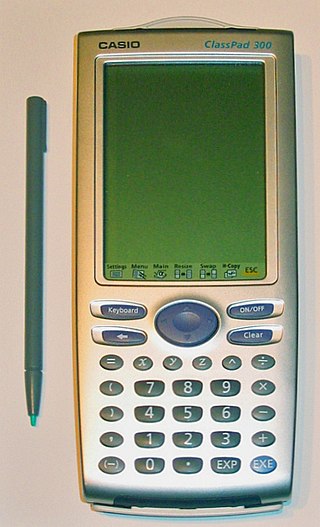
The Casio ClassPad 300, ClassPad 330 and fx-CP400 are stylus based touch-screen graphing calculators. It comes with a collection of applications that support self-study, like 3D Graph, Geometry, eActivity, Spreadsheet, etc. A large 160x240 pixel LCD touch screen enables stylus-based operation. It resembles Casio's earlier Pocket Viewer line. HP and Texas Instruments attempted to release similar pen based calculators (the HP Xpander and PET Project, but both were cancelled before release to the market.
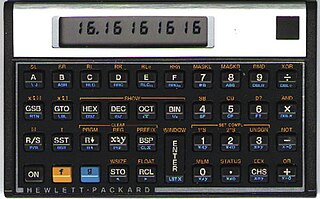
The HP-16C Computer Scientist is a programmable pocket calculator that was produced by Hewlett-Packard between 1982 and 1989. It was specifically designed for use by computer programmers, to assist in debugging. It is a member of the HP Voyager series of programmable calculators. It was the only programmer's calculator ever produced by HP, though many later HP calculators have incorporated most of the 16C's functions.
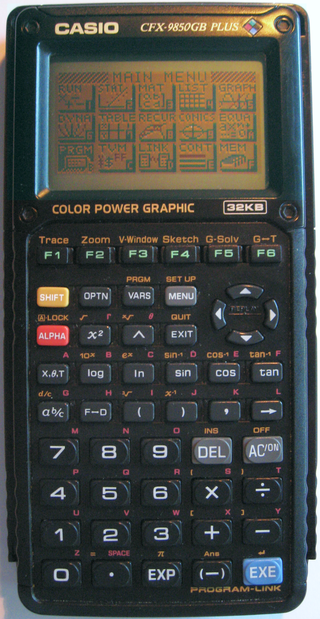
The Casio CFX-9850G series is a series of graphing calculators manufactured by Casio Computer Co., Ltd. from 1996 to 2008.

Casio Databank is a series of digital watches and electronic personal organizers manufactured by Casio. The watches allow data storage for names and telephone numbers, memos, and in late editions, email addresses; in addition to usually providing a calculator as well as the standard features of a digital watch. The personal organizers allowed storage of names, telephones and fax numbers, memos and includes a "secret" storage area for memos which required a password to access.

Timex Datalink or Timex Data Link is a line of early smartwatches manufactured by Timex and is considered a wristwatch computer. It is the first watch capable of downloading information wirelessly from a computer. As the name implies, datalink watches are capable of data transfer through linking with a computer. The Datalink line was introduced in 1994 and it was co-developed with Microsoft as a wearable alternative to mainstream PDAs with additional attributes such as water resistance, that PDAs lacked, and easy programmability. The watch was demonstrated by Bill Gates on 21 June 1994 in a presentation where he downloaded information from a computer monitor using bars of light and then showed to the audience the downloaded appointments and other data. The early models included models 50, 70, 150 and model 150s. The model numbers indicated the approximate number of phone numbers that could be stored in the watch memory. These early models were, at the time of their introduction, the only watches to bear the Microsoft logo. The watches have been certified by NASA for space travel and have been used by astronauts and cosmonauts in space missions. There had been an evolution over the years as to the number and type of entries that can be stored in the various watch models as well as the mode of data transfer between computer and watch. At the time of its introduction the watch was considered high-tech.

Graphic calculators made by Casio include the touchscreen ClassPad 300 as well as the models with traditional buttons which can be divided into two main generations listed below. Casio produced the world's first graphing calculator, the fx-7000G.
The Timex Ironman is a digital wristwatch first produced by Timex in 1986, and continues to be made in various styles today.

A smartwatch is a wearable computer in the form of a watch; modern smartwatches provide a local touchscreen interface for daily use, while an associated smartphone app provides management and telemetry, such as long-term biomonitoring. While early models could perform basic tasks such as calculations, digital time telling, translations, and game-playing, smartwatches released since 2015 have more general functionality closer to smartphones, including mobile apps, a mobile operating system, and WiFi/Bluetooth connectivity. Some smartwatches function as portable media players, with FM radio and playback of digital audio and video files via a Bluetooth headset. Some models, called watch phones, have mobile cellular functionality such as making telephone calls.

The Casio Algebra FX series was a line of graphing calculators manufactured by Casio Computer Co., Ltd from 1999 to 2003. They were the successor models to the CFX-9970G, the first Casio calculator with computer algebra system, or CAS, a program for symbolic manipulation of mathematical expressions. The calculators were discontinued and succeeded by the Casio ClassPad 300 in 2003.
